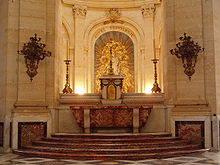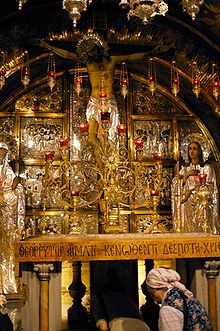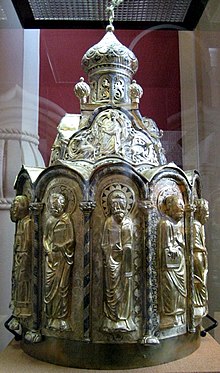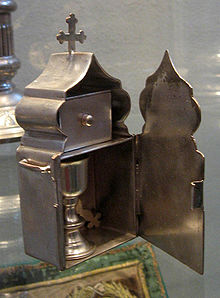
A tabernacle is a fixed, locked box in which, in some Christian churches, the Eucharist is "reserved" (stored). A less obvious container for the same purpose, set into a wall, is called an aumbry.
Within Catholicism, Eastern Orthodoxy and in some congregations of Anglicanism and Lutheranism, a tabernacle is a box-like vessel for the exclusive reservation of the consecrated Eucharist. It is normally made of metal, stone or wood, is lockable and secured to its altar or adjacent wall to prevent the consecrated elements within from being removed without authorization.
The "reserved Eucharist" is secured there for distribution at services, for availability to bring Holy Communion to the sick, and, especially in the Western Church, as the center of attention for meditation and prayer. The term "tabernacle" arose for this item as a reference to the Old Testament tabernacle which was the locus of God's presence among the Jewish people - hence, it was formerly required (and is still generally customary) that the tabernacle be covered with a tent-like veil or curtains across its door when the Eucharist is present within.
By way of metaphor, Catholics and Orthodox alike also refer to the Blessed Virgin Mary as the Tabernacle in their devotions (such as the Akathist Hymn or Catholic Litanies to Mary), as she carried within her the body of Christ in her role as Theotokos.
The following historical information is found, for instance, in the article The casing of the Eucharist by the Secretary of the Congregation for the Clergy, Archbishop Mauro Piacenza, who also heads the Pontifical Commission for the Cultural Patrimony of the Catholic Church, in 30Days, No. 6 Year XXIII – June 2005.
In early Christianity, priests and or lay people commissioned by them took bread consecrated at their Eucharist to their homes, in order to give it to the sick and others unable to attend the celebration. But when the Edict of Milan ended persecution, and the early Church was allowed to practice its religion publicly, the Eucharist was no longer kept safeguarded in private Christian homes, but was reserved near the altars of churches.
The preferred containers, the original "tabernacles", then had the form of a (usually gold) dove within a (usually silver) tower. There is mention of a gift of these two vessels, both of gold and adorned with 250 white pearls, that the Emperor Constantine gave to Saint Peter’s Basilica in Rome, and of silver towers and golden doves given to particular churches by Pope Innocent I and Pope Hilarius.
The vessels were kept in a place called the "sacrarium" or "pastophorium" away from the central body of the church or were suspended by fine chains from the middle of the canopy (hence called a "ciborium" or bread store) above the altar of the church. Gian Lorenzo Bernini’s 29-metre-high Baroque baldacchino over the main altar in today’s Saint Peter’s Basilica is at present the best-known such structure. Later, simpler vessels replaced to some extent the dove and the tower.
By the thirteenth century, the Eucharist was most often kept in a highly embellished cabinet inserted into the wall to the right or left of the altar. The Altar lamp indicated the Presence of Christ. This was a means of following the decree of the 1215 Fourth Lateran Council requiring that the reserved sacrament be kept in a locked receptacle.
In the late fourteenth century, special stone constructions for the Eucharistic bread began to be built, especially in northern Europe. In German and Netherlandish churches of the period, such structures can still be seen: tall towers, known in German as Sakramentshäuser, in Dutch as sacramentstorens, usually placed to the north of the altar and often reaching almost to the ceiling. They were in use until the mid-nineteenth century. As the presence of the sanctuary lamp in the picture to the right shows, some have been returned to their traditional use.
German examples are found in the church of St Lawrence in Nuremberg (18.70 metres), the minster of Salem (16 metres), Saints Peter and Paul city church in Weil der Stadt (over 11 metres), the church of Our Lady in Lübeck (9.5 metres), and St Mary's Cathedral in Fürstenwalde upon Spree. Belgian churches with such sacrament towers include St Catherine's in Zuurbemde, St Martin's in Kortrijk, St Peter's and St James's in Leuven, and St Leonard's in Zoutleeuw.
In the early sixteenth century, Bishop Matteo Giberti ordered that, in his diocese of Verona, in Italy, the container case for the consecrated bread should be placed on an altar. The custom spread through northern Italy. Saint Charles Borromeo, who became Archbishop of Milan, Italy in 1560, had the Sacrament moved from the sacristy to an altar (not the main altar) of his cathedral. The edition of the Roman Missal revised and promulgated by Pope Pius V in 1570 (see Tridentine Mass) still did not envisage placing the tabernacle on an altar: it laid down instead that the altar card containing some of the principal prayers of the Mass should rest against a cross placed midway on the altar (Rubricae generales Missalis, XX - De Praeparatione Altaris, et Ornamentorum eius). However, in 1614 Pope Paul V imposed on the churches of his diocese of Rome the rule of putting the tabernacle on some altar. Reaction to Protestantism's denial of the reality and permanence of the Real Presence of Christ in the Eucharist then led to the spread of the placing of the tabernacle even on the high altar, so as to make it more evidently visible. Whether on the main altar of the church or in a special chapel, the tabernacle became more and more large and ornate, to the extent of dominating the altar.
Present norms
Catholic Church
Tabernacle at Cathédrale Saint Louis de Versailles
The renewal of the Roman-rite liturgy following the Second Vatican Council (see Mass of Paul VI) was to highlight the primacy of the Eucharistic celebration itself, more than just a means for providing the permanent Eucharistic presence. The altar, it was decided, should be "truly the centre to which the attention of the whole congregation of the faithful naturally turns".[1] Before Vatican II, Mass was often celebrated directly in front of the tabernacle. Today, most often, the altar for the celebration of Mass stands on its own, and the tabernacle is given its own, usually smaller, altar or it stands nearby on a pedestal or in its own separate chapel. This allows the faithful to focus on the celebration of the Eucharistic action during Mass, but preserves a dignity of place and fosters prayer and meditation outside of Mass by giving the tabernacle its own space.
Before the 1960s, some bye-altars in Catholic churches also housed a tabernacle, in addition to that of the high altar.
- 314. In accordance with the structure of each church and legitimate local customs, the Most Blessed Sacrament should be reserved in a tabernacle in a part of the church that is truly noble, prominent, readily visible, beautifully decorated, and suitable for prayer.
- The one tabernacle should be immovable, be made of solid and inviolable material that is not transparent, and be locked in such a way that the danger of profanation is prevented to the greatest extent possible. Moreover, it is appropriate that, before it is put into liturgical use, it be blessed according to the rite described in the Roman Ritual.
- 315. It is more in keeping with the meaning of the sign that the
tabernacle in which the Most Holy Eucharist is reserved not be on an
altar on which Mass is celebrated. Consequently, it is preferable that
the tabernacle be located, according to the judgment of the Diocesan
Bishop,
- a. either in the sanctuary, apart from the altar of celebration, in a form and place more appropriate, not excluding on an old altar no longer used for celebration;
- b. or even in some chapel suitable for the faithful’s private adoration and prayer and which is organically connected to the church and readily visible to the Christian faithful.
- 316. In accordance with traditional custom, near the tabernacle a special lamp, fuelled by oil or wax, should be kept alight to indicate and honor the presence of Christ.
Eastern Orthodox Church
Reserved sacrament
The altar at Golgotha in the Church of the Holy Sepulchre, Jerusalem. In the center is an Orthodox tabernacle.
The ark or church tabernacle for a Russian Orthodox church (Dormition Cathedral in the Moscow Kremlin)
When Orthodox Christians receive Holy Communion, they always receive in both species: the Body and the Blood of Christ. This includes Communion taken to the sick. Therefore, both are reserved in the tabernacle. Every year on Holy Thursday, the reserved Mysteries are renewed. The priest will cut an extra Lamb (host) for that liturgy and after the consecration, just before the clergy receive communion, the priest will take the extra Lamb and carefully pour a little of the Blood of Christ over it. This Lamb will then be cut into very small portions, allowed to dry thoroughly, and be placed in the tabernacle. The deacon (or priest, if there is no deacon) will consume whatever remains of the previous year's reserved sacrament when he performs the ablutions.
Typically, a sanctuary lamp is kept burning in the Holy Place (sanctuary) when the Mysteries are reserved. This may be a separate lamp hanging from the ceiling, or it may be the top lamp of the seven-branch candlestick which sits either on top of the Holy Table or behind it.
Communion for the Sick
Small tabernacle for communion of the sick. At the top is a box for the
Reserved Mysteries (Reserved Sacrament), at the bottom is a small chalice, in the back is a tiny communion spoon with a cross on the handle (Kiev-Pecherski Lavra)
Rather than using a kit like the one described above, a priest may use a small chalice with a tight-fitting lid. He pours a little wine into the chalice, places a particle of the reserved Mysteries in the wine, and attaches the lid. He will take the chalice and a communion spoon to administer Holy Communion to the sick.
Presanctified gifts
A smaller tabernacle, sometimes referred to as a pyx, is used during Great Lent. This tends to be a rectangular, gold-plated box, often with a cross on top, with a hinged lid. On Sundays during Great Lent, the priest will consecrate extra Lambs (in the same manner as on Holy Thursday), for use during the Presanctified Liturgy. These Lambs will be kept in the pyx on the Holy Table, or sometimes on the Prothesis (Table of Oblation).Anglican and Methodist Churches
Many Anglican parishes use tabernacles, either fixed on the altar, placed behind or above it, or off to one side. As in Roman Catholic churches, the presence of the reserved sacrament is indicated by a "presence lamp" – an oil or wax-based flame in a clear glass vessel placed close to the tabernacle. Normally, only ciboria and Blessed Sacrament are placed in the tabernacle, although it is not uncommon for the wine or consecrated oils to be placed there as well. When the tabernacle is vacant, it is common practice to leave it open so that the faithful will not inadvertently perform an act of devotion (such as bowing or genuflecting). Tabernacles are customarily lined with, if not constructed from, cedar wood, whose aromatic qualities discourage insect life.E. J. Bicknell in A Theological Introduction to the Thirty-Nine Articles writes that "According to the first Prayer-Book of Edward VI the sick might be communicated with the reserved sacrament on the same day as a celebration in church."[2] Article XXVIII — Of the Lord's Supper in Anglicanism's 39 Articles and Article XVIII — Of the Lord's Supper in Methodism's Articles of Religion state that "The Sacrament of the Lord's Supper was not by Christ's ordinance reserved, carried about, lifted up, or worshiped."[3] The Rev. Jonathan A. Mitchican, founder of The Conciliar Anglican writes that this Article "does not explicitly ban these practices but does add a note of caution about them by pointing to the fact that none of them are biblical."[4] As such, the reserved sacrament was used by Anglican priests who held these views to administer communion to persons unable to attend church through illness. However, in 1885 the upper house of Convocation ruled against this practice, declaring "the practice of reservation is contrary to the wise and carefully revised Order of the Church of England".[5]
Among those Anglicans who identify as "Anglo-Catholics," the Protestant Reformation is often considered one episode in church history which no longer defines their faith as Anglicans. After the Oxford Movement, reservation became commonplace in large parts of the Anglican Communion, and some parishes also perform services of solemn benediction and/or other forms of Eucharistic adoration.
The Anglo-Catholic manual of rites and ceremonies Ritual Notes described tablernacles as generally made of wood (they could however be of gold, silver or even iron; if of iron this should be enclosed in gilt-wood, wrought metal or carved stone). If the material be metal there should be an inner lining of poplar or cedar wood and in any case a lining also of white silk or cloth of gold or silver. The tabernacle should be securely fixed to the altar or gradine, but away from the wall so that the conopaeum (a veil used to cover it when it contains the blessed sacrament) can completely surround it. The veil may be white or varying in liturgical colour. There may be a second tabernacle but not more in the same church but if so only one should be used at any time. A lamp should remain lit nearby when the tabernacle is in use.[6]






